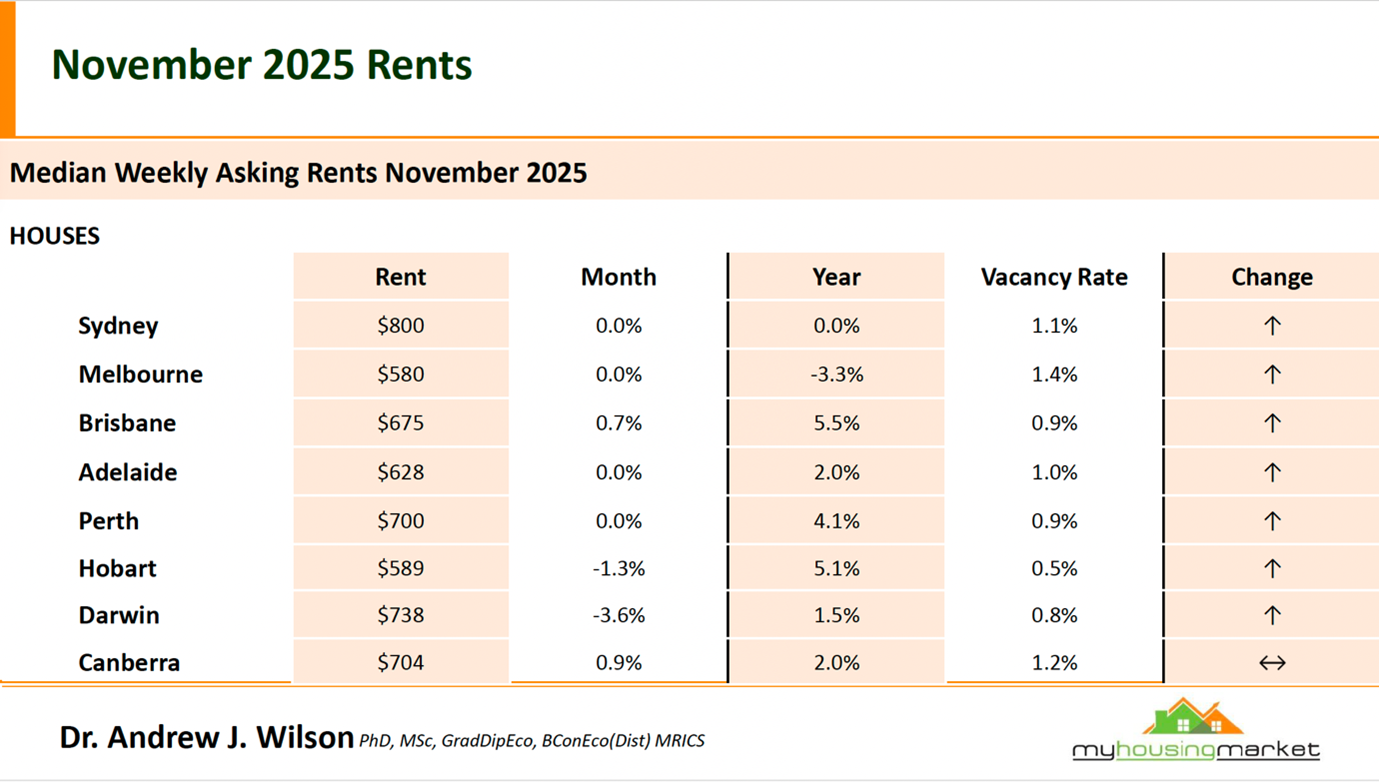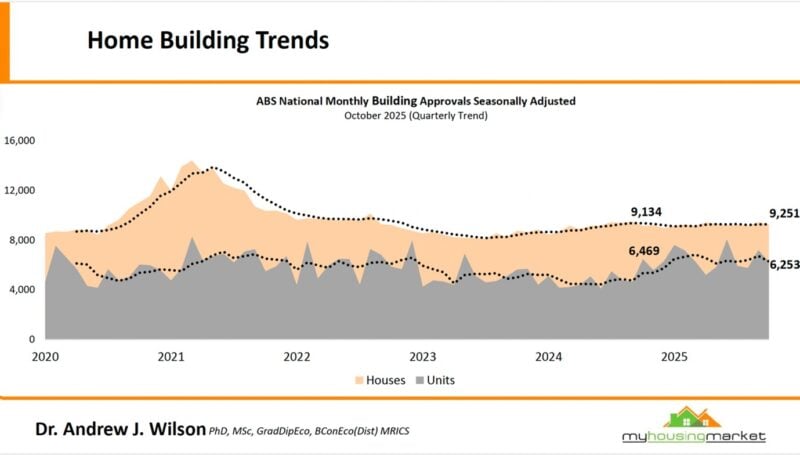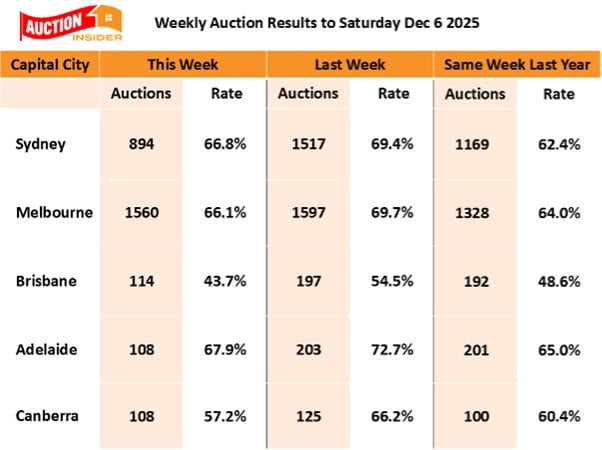
Key takeaways
Vacancy rates may have nudged up a touch in some cities, but they’re still below 1.5% in every capital (with Canberra steady).
November saw unit rents jump in most capitals: Darwin +5.2%, Perth +3.5%, Sydney & Brisbane +2.3%, Adelaide +1.9%, Canberra +0.9%, Melbourne +0.8% (Hobart was the exception at -1.3%).
Most capitals had stable house rents over November, with Brisbane +0.7% and Canberra +0.9%. But there were notable drops in Hobart (-1.3%) and Darwin (-3.6%). Over the year: Brisbane (+5.5%), Hobart (+5.1%) and Perth (+4.1%) led, while Sydney was flat and Melbourne was down 3.3%.
ABS dwelling approvals fell 6.8% in October, driven by a 13.1% drop in unit approvals and a 2.1% fall in house approvals.
Even worse, approvals are still more than 26% below the 2016 peak in capitals, and unit approvals are down more than 40% from 2016 highs—which basically “locks in” ongoing rental scarcity into 2026+.
Auction volumes and results are easing as the year winds down: the national clearance rate averaged 60.3% last week vs 66.5% the week before (and ~60.1% this time last year). That’s a normal seasonal fade-out—while the rental market remains the bigger pressure cooker.
If you’ve been told the rental crisis is easing, you’re about to see why that claim doesn’t stand up to the data.
Because the latest My Housing Market rent report reveals a story that’s both surprising and seriously concerning.
Unit rents are climbing sharply again across almost every capital city, vacancy rates are still hovering at crisis levels, and supply - instead of improving - is falling even further behind.
Add in shrinking building approvals and you’ve got a market that’s tightening in all the wrong ways - setting the stage for another year of rental pressure.
If you’re an investor, a renter, or simply someone trying to navigate the housing market, you need to understand what these numbers really mean - because they’re going to shape prices, rents, and housing opportunities throughout 2026 and beyond.
Unit rents rise with houses steady over November
Watch this week's Property Insider Chat as Dr Andrew Wilson explains how capital city unit rents generally increased over November, with house rents steady overall compared to the previous month.
Most capitals continued to report stable house rents over the month, with Canberra and Brisbane higher by 0.9% and 0.7% respectively.
Hobart house rents fell by 1.3% with Darwin down sharply by 3.6%.
Sydney continued to report the highest capital city house rents over November and steady again at $800 per week, with Hobart still the most affordable and lower again at $589 per week.
Brisbane, Hobart and Perth have recorded solid annual increases in house rents up by 5.5%, 5.1% and 4.1% respectively with Adelaide and Canberra each higher by 2.0% and Darwin up 1.5%.
Sydney’s annual house rents remain steady, with Melbourne down 3.3%.
House vacancy rates increased marginally in all capitals over November with the exception of a steady Canberra.
This reflects an easing of the strong demand seen in the previous month, but vacancy rates nonetheless remain at very low levels, with all below 1.5%, placing upward pressure on rents.

Unit rents surged in most capitals over November, indicating generally strong competition continuing for available properties.
Volatile Darwin was the top monthly performer with unit rents rising by 5.2% followed by Perth higher by 3.5%, Sydney and Brisbane each up 2.3%, Adelaide higher by 1.9%, Canberra up 0.9% and Melbourne rising 0.8%. Hobart unit rents, however, fell by 1.3% over the month.
Annual unit rents have increased in all capitals with Adelaide, Darwin, Brisbane and Perth highest, and up by 11.1%, 10.0%, 6.8% and 6.7% respectively.
Sydney remains the clear leader for weekly unit rents higher at $768, with Hobart still the most affordable and lower at $463 per week.
Similar to houses, capital city unit vacancy rates were mostly marginally higher over the month with most remaining low with the exception of Melbourne and Canberra that nonetheless reported monthly rent increases.

Home building approvals lower
Watch this week's Property Insider video above as Dr. Andrew Wilson explains how Australia’s building approval numbers continue to paint a worrying picture for the nation’s housing future.
Despite record levels of population growth and intense rental demand, the latest ABS data shows total dwelling approvals fell another 6.8 percent in October, reversing September’s brief recovery.

The decline was driven by a sharp 13.1 percent drop in unit approvals and a 2.1 percent fall in house approvals, highlighting a market struggling to produce the new supply our growing population desperately needs.
What’s most concerning for investors and policymakers is the longer trend: annual approvals remain at deeply depressed levels, with capital city approvals still sitting more than 26 percent below their 2016 peak.
In other words, Australia is building far fewer homes today than it did nearly a decade ago - at precisely the time we need them most.
This lack of construction momentum is not a short-term hiccup.
It reflects structural constraints that have been building for years: escalating development costs, planning bottlenecks, labour shortages, and financing challenges that continue to squeeze small-to-medium developers out of the market.
And with unit approvals down more than 40 percent from their 2016 highs, we’re creating a pipeline problem that guarantees continued rental pressure well into 2026 and beyond.
At a national level, approvals for both houses and units remain at levels that cannot meet current or future demand, which means the rental crisis Australians are feeling today is simply the first wave.
Without a substantial and sustained increase in construction activity, the imbalance between supply and demand will continue to drive rents higher, push home prices up, and make affordability an even tougher challenge for the next generation of Australians.
Auction markets on the slide to begin December
As the auction season winds down ahead of the end-of-year shutdown in two weeks, auction numbers and clearance rates have predictably eased.
The national weekend auction market reported an average clearance rate of 60.3% over the past week, which was lower than the 66.5% reported over the previous week and similar to the 60.1% reported over the same week last year.
Auction market activity will continue to ease over the coming fortnight, concluding a nonetheless exceptionally strong spring selling season.















